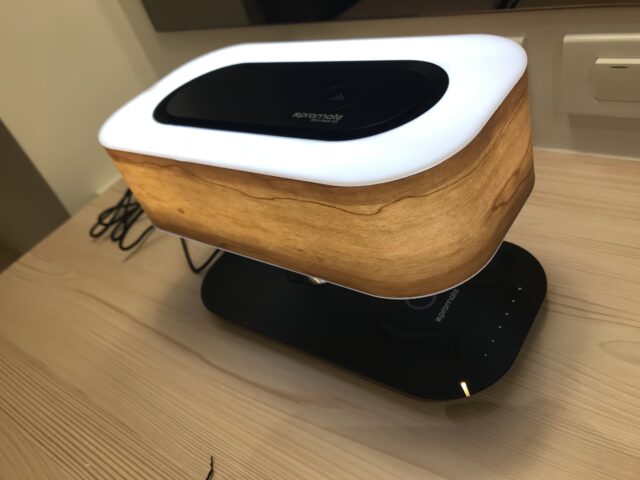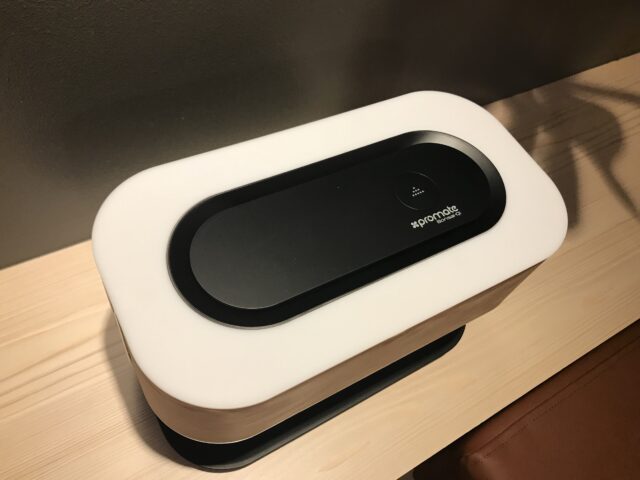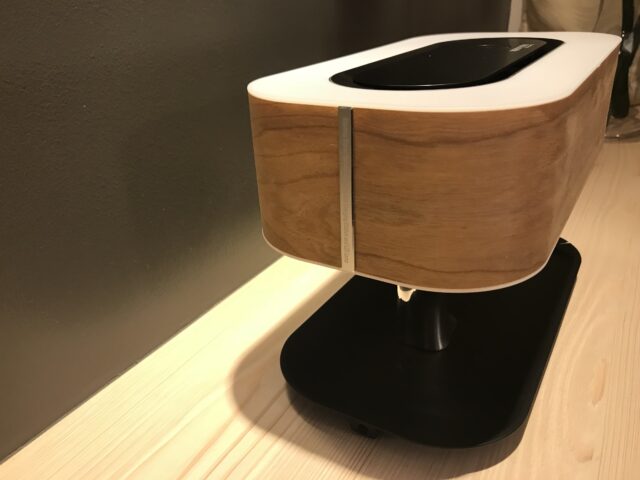Dubai-based technology lifestyle brand, Promate is one of those rare companies that make products with a lot of sense. Their selections usually combine ubiquitous functions into one. Wireless earphones with a powerbank as its case: check. Android tablet with a built-in projector: check. USB-C multi-port hub with ports for 4K HDMI, micro SD Card, Aux-in, Ethernet and three USB-3 ports: check. So its not too farfetched for Promate to churn out another product that makes us go, “why not?”.
Its latest offering is right up it’s multifunctional DNA: the Bonsai-Q – a wireless stereo speaker with Qi-charger and LED lamp.
The overall aesthetic and the name of the product itself is inspired by the Japanese art form of making small trees that mimic the shape and scale of full size trees. Naming it “Bonsai” did help me make sense of what it is. However, if called anything else, one might be challenged. The black base, combined with the chrome trunk and the wooden crown doesn’t exactly resemble any tree, bonsai-sized or not. The aesthetic link between device and bonsai isn’t apparent as one would hope. This was proven true one afternoon when I placed it in our dining room. A family member immediately quipped,
“Nice, what is it?”, my sister-in-law asked.
“It’s a wireless speaker”, I said.
“Oh, really. It looks nice. What’s with the silver stand?”, my sister asked.
“It actually connects the wireless charging base with the speaker on top”.
“Ah”, she remarked with eyes squinting and trying to make sense of the whole thing. After sensing her struggle for a few seconds, I helped her out.
“It’s bonsai-inspired”.
“Ah….”
Downtime lighting
The crown of the Bonsai-Q is where the speaker and the light reside. The faux wood panels hark back to the speaker designs of the 90s where wooden accents were en vogue. The material of the panel is actually made of a thin sheet of plastic, like that of a lamp shade. When lit-up, the Bonsai-Q accomplishes its task of enhancing that suave mood. In a dark room with the Bonsai-Q as the only light source, the soft yellow glow it emanates is perfect for downtime. The six dots at the base are actually the touch-sensitive sliders to control the light intensity. Slide your finger to the smaller dot, the light dims. Slide the other way to the bigger dot, it brightens. Tap any of the dots once, to turn on or off. The six dots – though they go from smallest to biggest – only represent four light intensity settings. Sliding your finger to the 3rd and 4th dot doesn’t do anything to the light. Why put six dots when only 4 settings are available is beyond me.
The top side is where you’ll find a physical Play and Pause button and touch-sensitive volume buttons. The former is actually the only physical button on this lamp while all others, including the sliding controls for lamp brightness located at the base are touch sensitive.
That familiar Divisoria voice
Plugging in the Bonsai Q immediately turns on the lamp by default. A voice then says, “connected” or “disconnected” depending on its Bluetooth connection status. The voice used though is unmistakably that same female voice we’ve heard from those stubby cylindrical bluetooth speakers that we usually get as company giveaways from Divisoria. The accent is so distinct that family members, especially the kids, mimic and make fun of it every time the Bonsai-Q blurts it out. Promate could’ve just used a beeping sound and avoid that cringe-inducing voice prompt we’ve heard from Bluetooth speakers of the lesser kind.
Stay away from the bass
Sound-wise, this is where Promate unfortunately suffers. After weeks of testing the unit, it now sounds like a cracked speaker. Mind you, I didn’t put it at the maximum volume level but how it sounded right off the box seemed like I put it through a lot. Playing Imagine Dragon’s “Thunder” sounds like it’s tearing up the whole Bonsai Q. Kendrick Lamar’s “All the Stars” with its drawn-out bass lines is more unforgiving and will leave you no choice but to turn the volume way down. The rattling sound is just too much to bear even on a normal, easy-listening volume. Switching to genres that are more mid and high friendly, like acoustic and jazz is where the Bonsai Qi delivers. Ed Sheeran’s acoustic rendition of Castle on the Hill sounded crisp and clear especially without gleeful strumming of the guitar at the chorus. You could argue that the aesthetic look isn’t really for the oomph in rock nor the thump of hip-hop but the speakers should have the all-around capability to deal with all genres that the common folk listen to.
Qi-charging
On the plus-side, I’ve had no issues on the Qi charging. Just put on your Qi enabled smartphone on top of the charging pad and it charges the same rate as the wireless chargers in the market.
Final thoughts
The Bonsai Q is a looker and a conversation-starter. It’s not everyday that you see a room accessory that can pull-off a wood and chrome aesthetic without looking tacky. The way it softly illuminates a corner or a bedside table is pleasing to the eyes and can go well with a room that’s accented with metal or wood. It’s a fine substitute for a mood lamp and is also a reliable wireless charger for your Qi enabled phones. However, it falls flat on its back with the audio department starting with that head-scratcher of a voice-prompt and that painful vibration coming from the speakers. The Bonsai-Q could have been Promate’s way to make it a bedroom mainstay. Unfortunately, it doesn’t sound as good as it looks.
Allan Abaca is an avid gamer through and through. Virtually, he is locked-in with his PS4 almost daily and has just introduced the awesomeness of gaming to his two sons.
Next in his sights is PC gaming. The platform which he nows considering going back to after a two decade hiatus.
Oh, and let's not forget the Nintendo Switch...
His psn id is hip2b2









